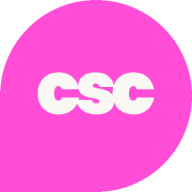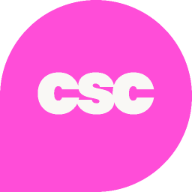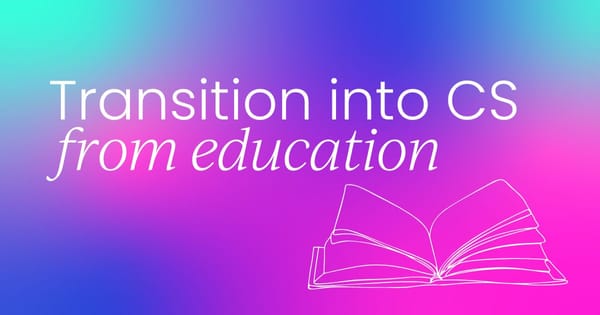If you do so much as a quick Google search, you’ll find many stories about people taking the education-to-customer-success pipeline. But why is this? And what are the skills that make it so common.. and how do you do it?
These are the questions we’re hoping to answer today. Specifically, in this article we’ll cover:
- Why transition to customer success
- Notable transferable skills
- Key differences between the professions
- Skills to develop before making the transition
- 5 steps to transition into customer success from education
Let’s get going.
Why transition to customer success?
So, the first thing to address is why should this transition be made in the first place. We’ve already said it’s quite a common pipeline, so what motivates these career shifts?
As with most career changes, the motivation can be anything from work-life balance to exploring your transferable skills, but why are teachers choosing customer success?
Customer success is similar to teaching in that it nurtures growth and learning within customers. While in the classroom, educators guide students toward their academic goals, customer success professionals do something similar.
Instead of textbooks and lesson plans, customer success managers (CSM) work with products and services. The "students" become valued clients, each with unique objectives and challenges.
In essence, the core of the work within these two roles remains similar. In many ways, customer success almost feels like teaching on a grand scale.
It’s all about finding where you fit. Megan Wardwell said regarding her own transition to customer success:
“I realized that my work-life balance was all out of whack and just something had to give. And knowing that I kind of always had in the back of my mind I wasn’t happy with where I was teaching. I was trying to find that place. And I knew that I needed to make some kind of a change, in order for myself to stay sane. Because with everything going on in my life things were kind of turbulent.”
So let’s look at why customer success comes up as a common career transition for teachers. It’s all about the transferable skills...
Transferable skills needed
When it comes to customer success, teachers are particularly adept at the role because it works well with the skills they’re already well versed in. Things like:
- Communication
- Problem-solving
- Adaptability
- Project management
- Leadership
- Instructional design
- Empathy
- Training and onboarding
- Creativity
- Strategic planning
- Accountability
As you can see, there’s a lot of crossover. But which are the most important?
We’d say the three top transferable skills are:
1. Project management
This one is an easy top pick. Teaching roles are always juggling a variety of different goals within the classroom and customer success is no different. The main difference here is that customer success deals with more open-ended timelines.
Where teachers are beholden to term times and exam seasons, customer success projects can work consistently throughout the year (and into future years too!).
2. Training and onboarding
Those first few months of a new year are the most important when making students feel comfortable in school and making it a safe place to learn, make mistakes, and grow.
The same goes for customers; working with customers through the first few months with a new product or service will ensure that they’ll remain with you for a long time.
3. Empathy
As with teaching, customer success professionals tend to be the first point of contact for regular customers (i.e. students) and trickier customers (i.e. parents!). Listening, engaging, and relating to the issues brought to you will make you skilled in understanding how to solve each issue so all parties are happy.
Key differences between education and customer success
Education does have its differences to the customer success field, namely in that CS is built within business structures. They have different goals, though they may go about achieving them in similar ways.
This is different from the goals of teaching, but as we mentioned in the previous section, teaching has a strong set of transferable skills to set you apart from the rest. (The same might not be true for the reverse.)
So, let’s lay out the most important differences:
1. Primary goal
As we’ve said, education aims to impart knowledge and develop skills. While customer success secondary goals may align with this too, the primary goal of a CS manager is to ensure customers achieve their desired outcomes with a product/service.
2. Motivation
Education is utilized by students for personal growth, career preparation, and other certification. While CS may align with this when working in edTech companies, the general motivation for customer success is to maximize value from a purchased product/service.
3. Measurement of success
This is an area where many teachers may need the most adjustment. In education, success is based on things like grades, test scores, and skill demonstration. Customer success metrics will include things like customer retention, satisfaction, and product adoption rates.
This data won’t be something usually applied to education, so this is an area that those aspiring to become CS professionals may benefit from learning a bit about prior to their new role.

Skills to develop before transitioning into customer success
So, we’ve said how some parts of the role may be different, but what skills should those currently in education be working on before making the transition to customer success?
Business analysis
Teachers transitioning to customer success need to understand how businesses operate and make decisions.
Not only do you have to understand the information you’re getting from customers, data, and other parts of the business, but you also have to be able to analyze this information and make informed decisions.
Getting well-versed in this type of analysis will enable you to identify customer needs and pain points (and patterns within them), align these solutions with overall business goals, and provide actionable insights to other teams and stakeholders.
Business acumen
Moving into the business space is daunting no matter when you make the leap. Understanding how individual businesses work, and how they interact with the market as a whole is vital.
Teachers should also take the time to learn about the most common business models they could come across, as well as the most common industries that use customer success.
On top of all this, there’s knowing the lingo. Business speak comes with a lot of acronyms and jargon that can be difficult to keep up with when you’re hearing it in a casual conversation for the first time. But you’ll have to know these if you want to make client conversation as smooth as possible.
Another important role of developing this skill is that it’ll help you recognize the role your product or service has within your industry of choice, how it helps clients, and how it’s different from any competitors.
Data modeling
In customer success, data-driven decision-making is key. Customer success goes beyond mere analysis; you’ll have to be able to create frameworks to track things like customer health and success metrics. Data modeling is vital to understand if you want to create frameworks that, well, work.
Data modeling is also a skill that develops your ability to predict customer behaviors. Working on this skill will make it that much easier to identify at-risk accounts and act accordingly.
5 steps to transition into customer success from education
So, you want to transition into customer success? If you’ve worked in education, you’ll find a lot of overlap in the skills required for these positions.
But once you’ve decided to transfer into customer success, what steps should you take to ensure you’re entering the role in the best possible way?
We’re going to take you through the following five steps:
- Identify transferable skills
- Research the industry
- Network
- Research role variations
- Get hands-on experience
Let’s get going.
1. Identify transferable skills
The first step will be to get as much clarity on the skills needed for the customer success role and identify which ones you already have in your toolkit.
As we covered in the first part of this article, there is a surprisingly large crossover between education and customer success, and the transition between the two is fairly common.
Educational positions do a lot to set up some of the more complex skills required of a customer success manager, so you’ll be able to rule out the skills you already have and focus on the ones you need to make your transition a success.
2. Research the industry
As with any industry, customer success has its own nuances, quirks, and ways of working.
You’ll want to have even just a basic understanding of what to expect before applying for any positions. Absorb as much information as possible, whether through books, podcasts, blogs, or more.
One of the best ways to do this is to listen to people currently in the industry. There are a few ways to go about this.
a) Ask directly.
Use LinkedIn, Reddit, or other forums (like the CSC Slack Community) to talk to people already in the industry. Most people will be very willing to take the time to chat with you and answer any questions you might have. This is their passion, so take the opportunity to learn as much as possible.
b) Sign up for courses.
Whether it's a short skill courses on LinkedIn, or more comprehensive ones (like those we’re known for!)
3. Network
The fantastic thing about conducting research is that it automatically begins connecting you to others within the industry. Your network is already beginning to form!
Talking with others via LinkedIn or on forums means you’re already integrating yourself into the conversations going on.
a) Attend in-person events.
Face-to-face interactions are a fantastic resource that is becoming less common in the current digital age, but it’s events like this that’ll give you a truly authentic feel of the industry as it currently is.
b) Attend virtual events or webinars.
Even if there aren’t any customer success events in your area, there are always virtual events going on in the industry. CSC has regular webinars where a single CS professional will talk about a specific topic. We also have full-on virtual events, where you’ll have a whole day's worth of talks and Q and A’s to be a part of.

One thing to do more of, once you’re familiar with the industry as a whole, is to work on presenting yourself.
Think about how your profile on LinkedIn showcases your strengths, how it highlights your interest and passion for the customer success industry, and how you’re working toward a future transition.
Julie Raeder, Customer Success Manager at SendSafely, talked through her own transition into customer success and recommends using a story to showcase your strengths:
“Your LinkedIn profile should act as your resume. People view it when you network with them and engage with their posts. Make it POP. Make it YOU […]
"Write an engaging about section. Use this section to tell your story and pique people’s interest. The first few lines of my LinkedIn summary act as the 'hook,' driving people to click to 'see more.'
"But don’t stop there! They should be compelled to read every line. By the end of your about section, they should understand your story but want to know more.”
4. Research role variations
There isn’t just one kind of customer success role. To name just a few, customer success includes titles like:
- Customer success manager (CSM)
- Customer success representative (CSR)
- Customer success analyst
- Customer education specialist
- Customer success operations manager
- Customer success specialist
- Customer success coordinator
- Customer onboarding manager
Just to name a few.
And on top of this, each of these roles will change depending on the type of business they’re working with. It’ll be influenced by things like:
- Type of product (physical, SaaS)
- Type of customer (B2B, B2C)
- Size of business (start-up, enterprise)
- Rate of business growth
Now that’s a lot of factors to consider, so do your research on as many as you can, and then pick the ones that seem right for you. Start with just one or two to become really familiar with, and then go from there.
5. Get hands-on experience
Experience is the key to the game. While getting credits and certifications is vital to this transition, you’ll want to back up all you’ve learned with some hands-on experience.
Moving into a completely new industry is a challenge because of the nature of having to essentially "re-spec" your skills and experiences to cater toward this new role.
So, in order to get your foot in the door for paid work, take a little bit of time to assume volunteer or freelance roles. Even just a two-week internship can go a long way to giving you the credibility you need to begin applying for these roles.
Let's help you get that customer success job of your dreams
If you're looking for a way to tone your customer success skills before diving into the role itself, we've got just the thing.
Crafted with some of the brightest and most experienced minds in the industry, our Customer Success Core: Certified program has been designed to equip you with the skills and knowledge needed to set you and your customers up for success.
By the end of this course you'll be able to:
- Understand metrics
- Advocate for customers
- Build a CS strategy
Sounds good?
P.S. Looking for something a bit more specific? We've got a ton of courses for each of the main parts of the customer success role.



 Follow us on LinkedIn
Follow us on LinkedIn







